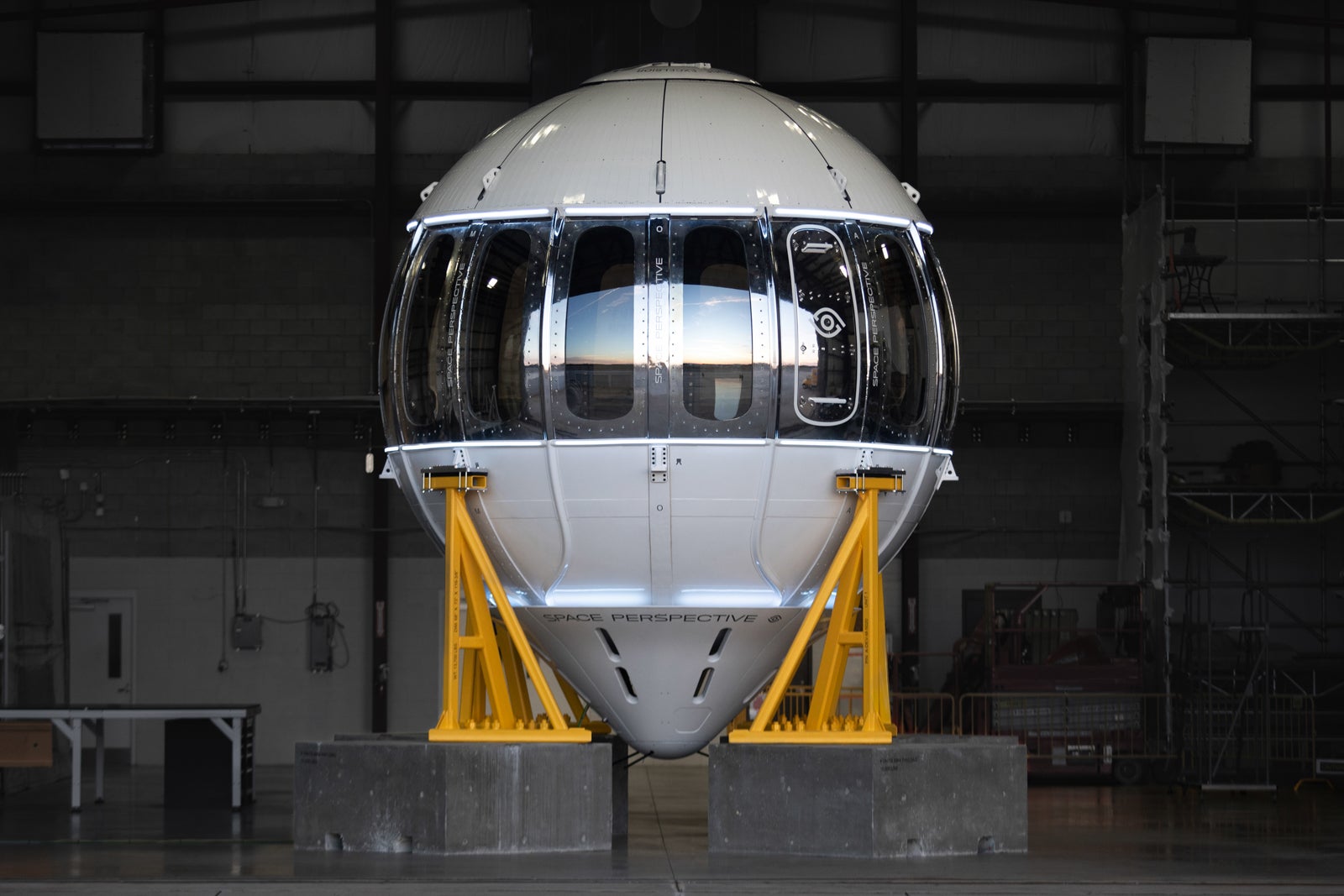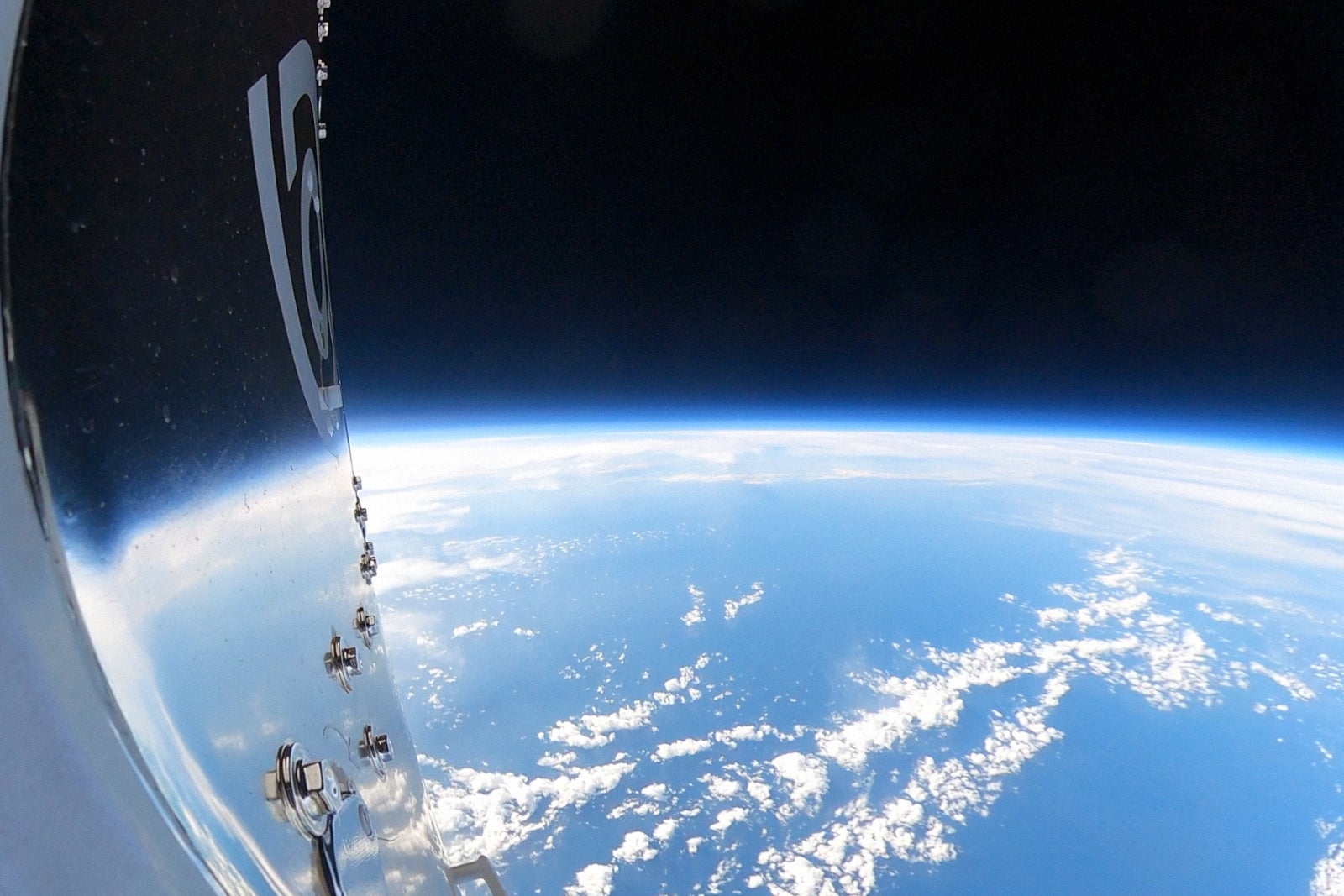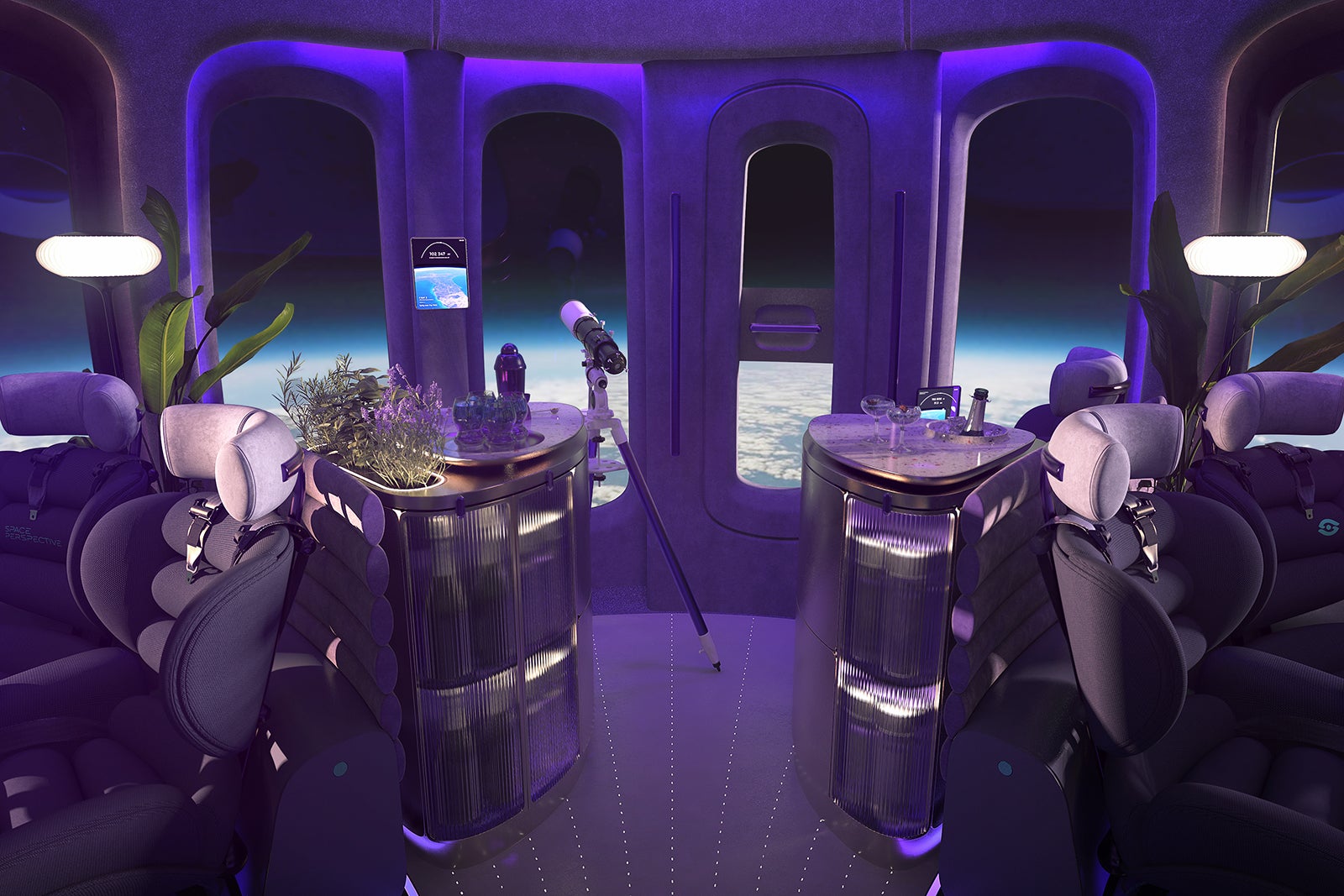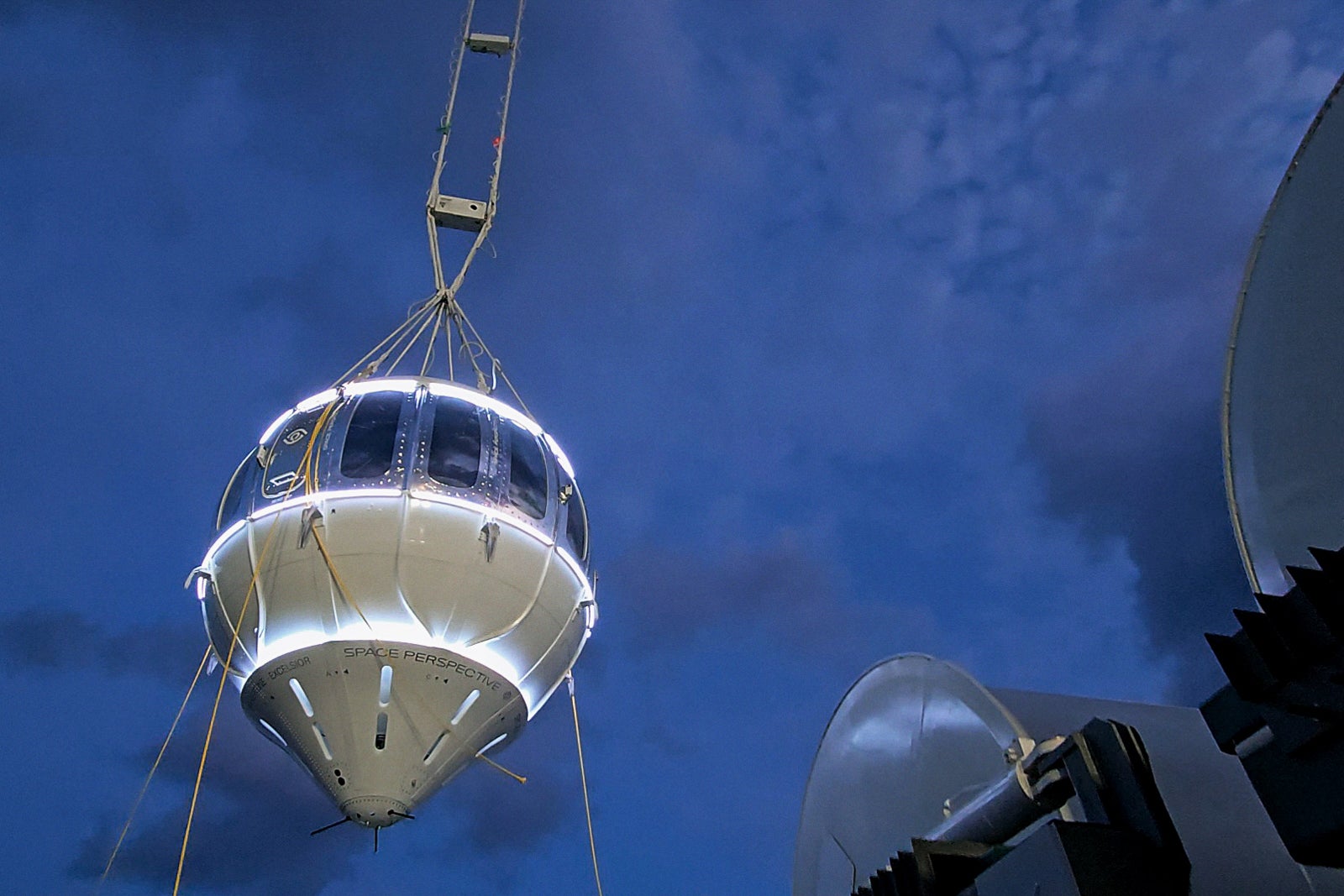Space Perspective plans first manned flight in 2025

If you fly front cabin frequently, you can expect certain things: comfortable and spacious seats, reliable Wi-Fi, and quality meals and cocktails. These amenities are common at altitudes of 35,000 feet, but a new travel company is about to take the luxury flying experience to a whole new level—100,000 feet, to be exact.
Space Perspective, the world’s first stratospheric balloon flight experience company, completed its first unmanned test flight on September 15, 2024. .
Related: Want to live or visit space? This exhibition provides a preview
TPG spoke with Space Perspective co-founder Taber MacCallum and interim CEO Michael Savage to learn more about the company’s unique brand of space tourism and what the experience will entail.
What is spatial perspective?
Without rockets, how would a space perspective transport travelers to the stratosphere and back safely to Earth? It’s all thanks to the Neptune spacecraft – a 16-foot-diameter spherical pressurized capsule that can accommodate up to eight passengers and a captain.
The journey begins aboard the Marine Spaceport Voyager, a 294-foot-long vessel that serves as the launch and recovery point for Space Perspective spacecraft. Voyager is currently based in Cape Canaveral, Florida, but is designed to launch from sea bases around the world.
According to MacCallum, typical flights will depart in the morning (although if you purchase a ticket, I imagine you’ll have some influence on departure times). “We’ll inflate the balloon so it’s upright above the capsule and secure the capsule to the deck of Voyager,” he explained. “The passengers will then enter the capsule and we will conduct a safety briefing, similar to a pre-flight briefing on a commercial airliner.”
Then, through Space Perspective’s patented SpaceBalloon, the Netptune capsule is gently lifted from the Voyager.
When the capsule is released from the launch ship, it will slowly ascend for two hours at about 12 miles per hour, a speed McCallum likened to the speed of riding a bicycle. “Then we’re floating at the top of the Earth’s atmosphere at 100,000 feet [the highest altitude of any commercial balloon flight in the world] A few hours.

daily newsletter
Reward your inbox with TPG daily e-newsletters
Join over 700,000 readers and get breaking news, in-depth guides and exclusive offers from TPG experts
McCallum continued: “Then we started descending, which was kind of the opposite of ascending. We descended for about two hours to get to the splash point [where a Splashcone at the capsule’s base will facilitate a gentle water landing] The recovery ship was then waiting for us at the splashdown site.
The ship will stabilize the capsule and transport it back to the Voyager, a process that takes about 20 minutes.
My most pressing question for McCallum has nothing to do with the technology and expertise that makes this possible. I just want to know the origin of the name Neptune. McCallum’s answer did not disappoint.
“I came up with this in a dream,” McCallum told me. “I did have a dream, and it said, ‘This is the spaceship Neptune.'”
It sure sounds great, but it also has important scientific implications thanks to McCallum’s long history in hot air ballooning and space travel. “The interesting thing about the name Neptune is that its atmosphere is mainly helium and hydrogen,” he explained. Neptune’s atmosphere is essentially made up of the “lift gases” used to lift balloons into the air.
Who will regulate space tourism?
When you combine sea launch sites with spacecraft, you get “a lot of regulatory agency,” in McCallum’s words.
“All the flying objects we have and all the ground operations associated with the flying objects are regulated as spacecraft by the FAA’s Office of Commercial Space Transportation,” McCallum explained. “Everything we do on board is Under the supervision of the Coast Guard.”
While the U.S. Federal Aviation Administration (FAA) has no clear limits on the edge of space, it does classify as a spacecraft any vehicle intended to operate with humans within a range of about 30 kilometers (or about 98,000 feet).
“Once you get to 30 kilometers or above, you’re basically in space,” MacCallum said. “It’s essentially a vacuum, and you have all the thermal, radiation and navigation problems of an airplane.”
Even if SpaceX could one day launch from locations outside the United States, it would still be subject to spacecraft regulations under the 1969 Outer Space Treaty. —run operations so we will always be regulated by the FAA,” MacCallum explained. Most countries are signatories to the treaty, allowing Space Perspective to operate globally.
Focus on passenger experience
From the moment you take off to the moment you land, Space Perspective will provide the comfort, space and facilities to make the most of this extraordinary experience.
The capsule is surrounded by floor-to-ceiling windows, offering panoramic views of the scenic journey around Earth. Seats are designed for safety and comfort comparable to any commercial aircraft, and you’ll enjoy world-class food and beverage service on board.
Even the restroom, dubbed the “space spa,” dwarfs the first-class restrooms. The space spa is beautifully designed with soothing color schemes and windows that allow for uninterrupted views even when nature calls.
The Space Perspective team didn’t miss a detail when designing the Neptune capsule and Onboard experience; this includes the opportunity to work with Sir Richard Branson, who will be the co-pilot on the first manned flight. The other co-pilots will be McCallum and his wife, Jane Poynter, co-founder of Space Perspective.
“Richard is an experienced hot air balloon pilot,” Savage told TPG. Branson’s level of involvement goes beyond that of a typical investor. “This is something he is personally very passionate about and he brings expertise and a commitment to customer experience to the table.”
While Branson wasn’t formally involved early on, it was clear that the Space Perspective team shared his ethos of exceeding customer expectations. “Things like flying the largest windows in space presented some challenges, but we did it because Jane wanted to push the experience,” Savage said.
Prioritizing customer experience also influenced the capsule’s layout. “We initially thought everyone would want a seat in front of the window and there would be a circle of seats,” McCallum said. “We immediately realized this was a social experience that people wanted to share with each other and repurposed the cabin to Arranged in two groups of four hemispherical seats to better facilitate this interaction.”
The extended six-hour flight also gives guests time to savor their time in space in a way that resonates with them. “One of the reasons it’s important to have time is so you can contemplate the stunning scenery, interact with other people, or get that final Facebook status update if you want,” McCallum said.
If you want to be one of the lucky few who tags your Facebook location as “space,” you’ll need $125,000 for a standard ticket on a Space Perspective flight. To date, Space Perspective has sold more than 1,800 pre-orders.
Many of these are for families or groups of friends looking for the ultimate getaway, but Space Perspective also gets some pretty “out of this world” requests. “We’ve had people buy a few tickets because they want to fly to Italy after seeing all of Florida from the edge of space,” McCallum said.
He also revealed that several artists have approached the company about becoming the first to release music from space. One passenger wanted to remove some seats and put in a grand piano to play in space.
Although the journey is designed to last six hours, the capsule can stay longer. “Our long-term roadmap may include overnight experiences,” Savage said. “We have the ability to design customized experiences, and as we grow, I believe we will bring a lot of interesting things to people.”
How is it different from other types of space tourism?
Unlike other experiences offered by space tourism companies, Space View flights are slow and gentle. Unlike flying into space and the weightlessness and gravity that comes with it, flying from a space perspective is closer to the experience of flying in an airplane.
This does not mean that the two experiences are in competition with each other. McCallum said Branson even sees the two as complementary. “People who are afraid of traveling in a rocket might do that first,” he said. “Their experiences were so different that he didn’t see them as competition at all.”
“If people want that thrill and go into space to the point of weightlessness, you can do that and have a great experience,” Savage said. Space perspectives, on the other hand, provide astronauts with different vantage points to observe The transformative experience described by Post-Earth.
“Many astronauts will tell you that they became astronauts to explore space, but they found that their relationship with Earth was forever changed,” Savage explained.
“The slow rise and fall of the space perspective gives you a sense of scale that rockets can’t get. You can look out the window and see your neighbors and then your community and your state and realize, ‘Maybe this Earth is what it is without me. It’s as big as I thought, I should have taken better care of it,” he added.
By the end of the journey, passengers will have spent six hours traveling to and from the stratosphere, including a full two hours looking down on our planet from a rarely visited vantage point.
Space Perspective is committed to making this life-changing journey accessible to as many people as possible.
“Imagine if every school had a teacher who had actually been to space,” said Savage, whose two sisters are school teachers. “They can talk to their kids about space exploration and it will make a fundamental difference.”
“There are charities that have been set up to send people like teachers and other leaders into space,” McCallum shared. “There’s an organization called Humanity in Space that is raising money to allow people to have experiences like this. They’ve sent people to Virgin Galactic and Blue Origin, so there’s a very large and growing community of sending people into space. Charitable component.
bottom line
Space was once considered the final frontier (at least according to Star Wars). Now, Space Perspective will soon take passengers to the luxury and comfort of “where no one has ever gone before.”
With high-end amenities, panoramic views and a gentle six-hour flight experience, Space Perspective’s stratospheric “atmosphere” tours are redefining what space tourism means.
Related reading:







